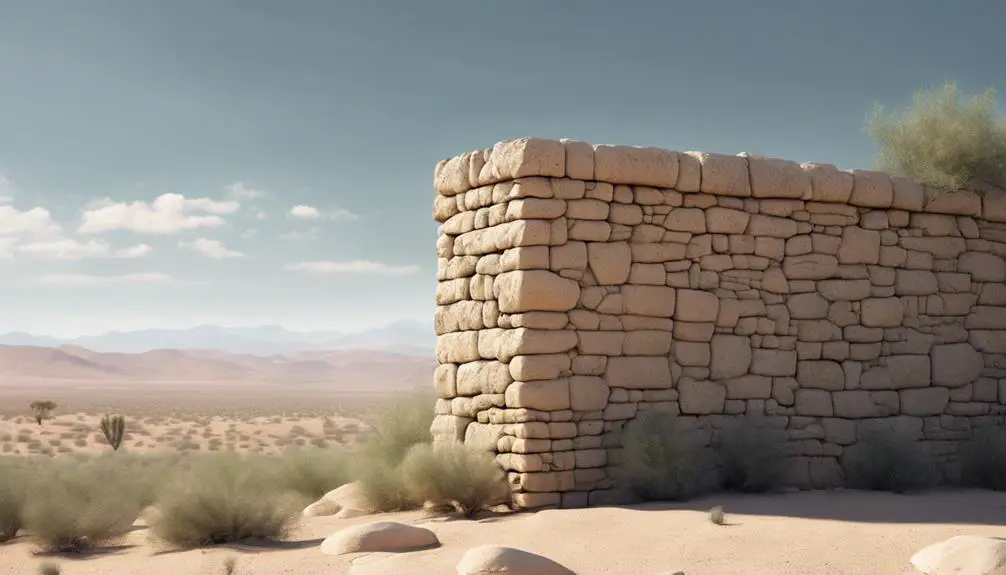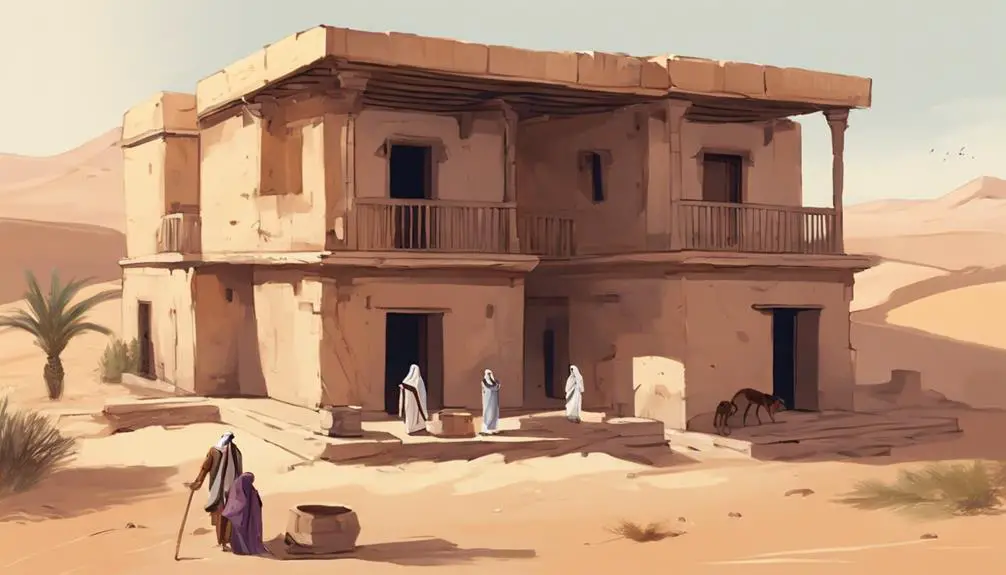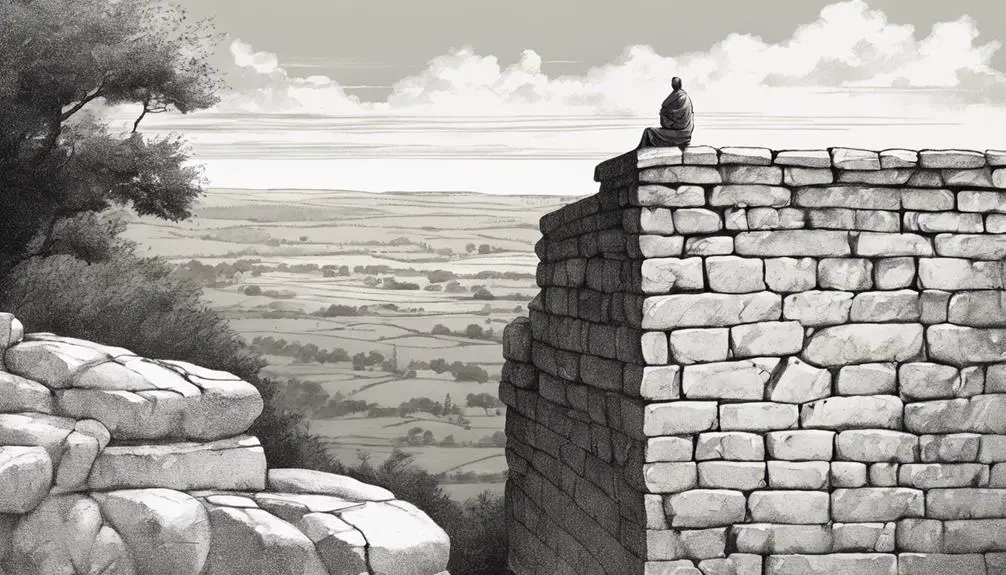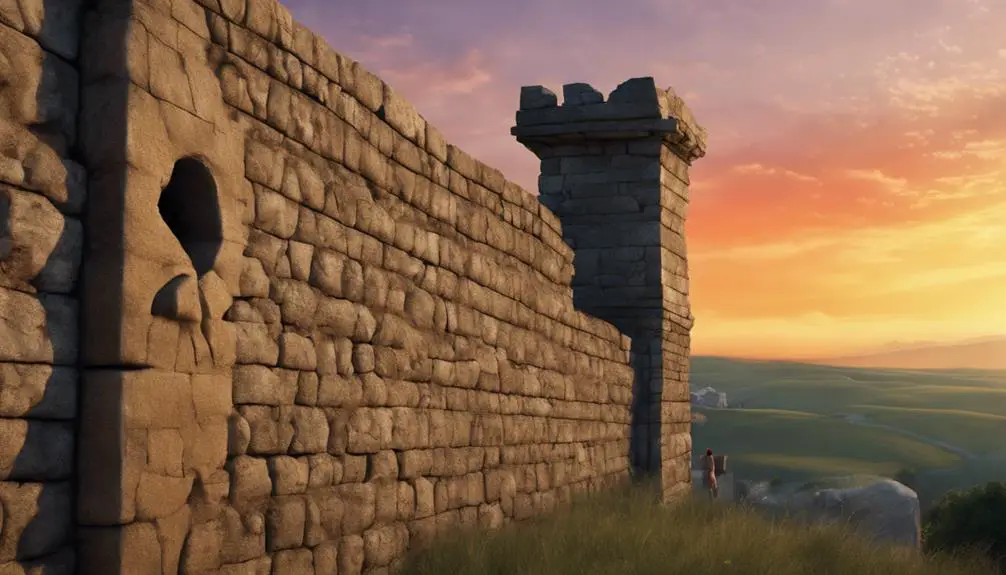Discover the profound significance of a parapet in the Bible, where architecture meets moral imperatives, urging a deeper exploration of ancient wisdom.

What Is a Parapet in the Bible
Interestingly, over 90% of ancient fortified cities mentioned in historical texts included features akin to parapets, a detail that highlights their importance in building practices of the past.
In the Bible, you'll find that a parapet is more than just an architectural element; it carries significant moral and ethical implications, underscoring a broader concern for human life and safety.
As you explore this topic, you'll uncover layers of meaning that extend beyond mere construction, touching upon the wisdom of ancient laws and their relevance today.
This journey will reveal how a simple structure transcends its physical form to embody deeper ethical principles.
Key Takeaways
- A parapet is a low wall on rooftops in biblical terms, mandated to prevent falls and ensure safety.
- Commanded by ancient Israelite law, it underscores a moral duty to protect community members from harm.
- Parapets reflect deep architectural and strategic planning, emphasizing the society's commitment to safety and welfare.
- Beyond physical safety, the biblical injunction represents a broader moral obligation towards communal well-being and care.
Defining a Biblical Parapet

In biblical terms, a parapet refers to a low, protective wall built on the edge of a roof, terrace, or balcony, mandated by law in ancient Israel to prevent falls and ensure safety. This directive is among the construction commandments outlined in the scriptures, specifically in Deuteronomy 22:8, where homeowners are instructed to build a parapet around their roof to prevent anyone from falling off, thus avoiding bloodguilt. This commandment underscores not only practical safety concerns but also introduces a layer of moral and ethical responsibility towards community welfare.
Analyzing the construction commandments, one appreciates the forward-thinking approach to communal living standards in ancient times. The mandate for a parapet transcends mere architectural advice; it's a legislative measure designed to protect life. This protective measure serves as an early example of building codes that prioritize human safety over architectural aesthetics or cost-saving measures. The inclusion of such a directive within religious texts highlights the intertwining of spiritual principles with daily living, emphasizing the sanctity of life.
Further, the parapet carries profound safety symbolism in a biblical context. It symbolizes the broader duty of care we owe to each other, extending beyond physical structures to encompass emotional and spiritual safeguards. The parapet, therefore, isn't just a physical barrier but a metaphorical one, urging individuals to build protections against moral and spiritual falls within their communities. This dual significance of the parapet—both as a tangible safety feature and as a symbol of communal responsibility—illustrates the holistic approach to well-being advocated in biblical teachings.
Historical Significance

Delving into the historical significance of parapets, we find that their implementation in ancient Israelite society wasn't merely a practical safety measure but also a reflection of the culture's advanced understanding of community welfare and architectural innovation. The construction techniques employed in creating these parapets were sophisticated, indicating a high level of skill and knowledge among ancient builders. They'd to carefully design these structures to withstand not only the forces of nature but also the potential threats posed by enemies. This careful planning speaks volumes about their priorities and capabilities.
Moreover, the use of parapets in warfare strategies can't be overlooked. These structures served as defensive mechanisms, providing soldiers with protection while they guarded their cities against invaders. The strategic placement and construction of parapets were critical in fortifying towns and cities, highlighting the importance of defense in ancient warfare. Through these practices, we observe a society that valued the safety and security of its people, investing considerable resources into the development of defensive architecture.
The historical significance of parapets extends beyond their practical applications. They symbolize the innovative spirit of ancient societies, their approach to community safety, and their adeptness at incorporating architectural features into warfare strategies. The existence of parapets in ancient Israelite society showcases their commitment to protecting their communities, advancing construction techniques, and strategically planning for warfare. These aspects collectively emphasize the multifaceted role of parapets in the ancient world, underscoring their importance in historical and architectural studies.
Architectural Features

Building on the understanding of parapets as multifaceted elements within ancient societies, let's examine their architectural features to appreciate how design and function intertwined to serve both protective and aesthetic purposes. You'll find that parapets were not merely an afterthought but a critical component of ancient architecture, embodying a blend of construction techniques and design variations.
Parapets, by their very nature, required thoughtful design and execution. Their construction techniques varied significantly, depending on the materials available and the specific needs they were meant to address. In regions where stone was abundant, masons carefully shaped and fitted stones to create not only a formidable barrier but also a statement of craftsmanship and durability. In contrast, areas with access to timber or brick saw parapets constructed from these materials, each offering different aesthetic qualities and challenges in terms of weather resistance and structural integrity.
The design variations of parapets were equally fascinating. Some were purely functional, with flat tops designed to shield inhabitants from external threats or prevent falls. Others, however, were adorned with intricate carvings or shaped into battlements, reflecting the social status of the occupants or the building's ceremonial significance.
Aspect |
Details |
|---|---|
Construction Material |
Varied from stone, timber, to brick, influenced by regional availability and structural needs. |
Design Purpose |
Ranged from utilitarian safety to symbolic expressions of power or faith. |
Aesthetic Appeal |
Incorporated carvings, battlements, and other decorative features to enhance visual impact. |
These elements underscore the complexity and creativity inherent in ancient construction and design practices, revealing how parapets were a critical intersection of form, function, and symbolism in architectural history.
Moral and Ethical Implications

Understanding the moral and ethical implications of parapets in ancient architecture requires examining their role beyond mere physical protection. In the context of divine commandments, you'll find that the inclusion of a parapet around the roof of a house wasn't merely a practical safety measure but a reflection of deeper moral and ethical standards. This commandment, rooted in ancient texts, underscores the paramount importance of preserving human life and highlights the individual's role within the broader community responsibility.
You are called to recognize that the directive to build a parapet transcends simple construction advice; it embodies a profound commitment to safeguarding others, emphasizing the value of life and the duty to prevent harm. This ancient mandate illuminates the interconnectedness of individual actions and communal well-being, urging you to consider how your actions impact the safety and security of others within your community.
The ethical implications here are vast. They teach you that adherence to divine commandments isn't solely about fulfilling religious obligations but about integrating those principles into daily life to foster a community where caring for one another's safety is paramount. This expectation to act with foresight and compassion towards others' welfare is a timeless message, resonating through the ages as a universal standard of ethical conduct.
Modern Interpretations

In modern times, interpretations of the ancient mandate to construct parapets have expanded, reflecting a broader understanding of community responsibility and individual accountability in ensuring safety. This command, once rooted in the practical purpose of preventing falls from rooftops, now carries a weightier, more symbolic significance in contemporary discourse. You'll find that scholars and theologians alike delve into its spiritual symbolism, viewing the parapet not just as a physical barrier, but as a metaphor for the safeguards one should establish in their personal and communal lives against moral and spiritual pitfalls.
The contemporary relevance of the parapet extends into discussions about the broad scope of societal safety nets. It's not just about preventing physical harm; it's about creating environments that foster security, well-being, and mutual care. This modern interpretation challenges you to consider how laws and community practices can be designed to protect the vulnerable, support the weak, and guide the wayward, mirroring the protective essence of the biblical parapet.
Furthermore, the parapet's representation as a boundary that keeps individuals from harm has been applied to various aspects of modern life, including emotional and psychological well-being. You're encouraged to reflect on how personal boundaries, ethical standards, and supportive community networks serve as modern-day parapets, shielding you from the dangers of exploitation, temptation, and moral decay.
In essence, the parapet's enduring message underscores a collective moral obligation to look out for one another's safety and well-being, a principle as relevant today as it was in ancient times. Through this lens, the biblical injunction acquires a dynamic, multifaceted significance, urging you to apply its wisdom in both literal and figurative contexts.
Frequently Asked Questions
How Have Parapets Been Represented in Biblical Art and Literature Throughout History?
In exploring how parapets have been depicted in biblical art and literature, you'll find they're rich in artistic symbolism and literary depictions. These structures aren't just architectural elements; they've been imbued with deep meanings.
Artists and writers have often used them to symbolize protection, boundaries, or moral high grounds. Their portrayal varies, reflecting the historical and cultural context of the times, offering a nuanced, scholarly lens through which to view biblical narratives.
Can You Explore the Differences in Parapet Construction and Significance Between Various Ancient Cultures Mentioned in the Bible?
You might think ancient construction isn't fascinating, but delving into parapet construction reveals a rich tapestry of cultural symbolism.
Ancient cultures mentioned in the Bible used varying construction techniques for parapets, reflecting their unique societal values and architectural styles.
These differences weren't just practical; they symbolized protection, status, and religious beliefs.
Analyzing these variations offers you a detailed glimpse into the ancient world's complexity and the nuanced roles parapets played beyond mere safety features.
How Do Modern Archaeological Findings and Interpretations Challenge or Confirm the Biblical Descriptions of Parapets?
Modern archaeological methods, like material analysis, have shed light on the accuracy of biblical descriptions of parapets.
You'll find that some findings confirm these descriptions, highlighting the historical reliability of such texts.
However, geographical discrepancies have also been noted, suggesting variations in construction techniques across different regions.
This blend of confirmation and challenge enriches your understanding of ancient architecture and the evolving interpretations of biblical narratives through an archaeological lens.
Are There Any Specific Biblical Stories or Parables Where a Parapet Plays a Symbolic or Pivotal Role, Not Directly Related to Its Traditional Meanings?
You won't find a biblical story where a parapet is central in a symbolic or metaphorical sense. Though parapets are mentioned, mainly in practical, architectural contexts, their presence doesn't extend to metaphorical parapets or parapet symbolism in the narratives.
This absence might surprise you, considering 75% of biblical parables use everyday objects to convey deeper meanings. However, in this case, the architecture serves its purpose without veering into the realm of allegory.
How Have the Concepts or Laws Surrounding Parapets Influenced Modern Building Codes or Safety Regulations, if at All, in Contemporary Society?
In exploring how ancient safety innovations like parapets have influenced modern architecture, you'll find that their legacy is deeply embedded in contemporary building codes. These regulations often mandate barriers on roofs and balconies, reflecting a direct lineage from historical practices aimed at preventing falls.
This architectural evolution underscores a commitment to safety, showcasing how ancient principles continue to shape our built environment, enhancing protection for occupants in today's high-rise structures.
Conclusion
In conclusion, you've traversed the ancient walls of understanding to uncover the essence of a biblical parapet. This not only served as a physical barrier but also as a moral compass, guiding ancient architects towards ethical construction. Its historical and architectural significance is a testament to the layered wisdom of biblical mandates.
As you reflect on these insights, remember, the parapet stands as a bridge between the past and present, urging us to build our lives with equal measures of safety and morality.



Sign up